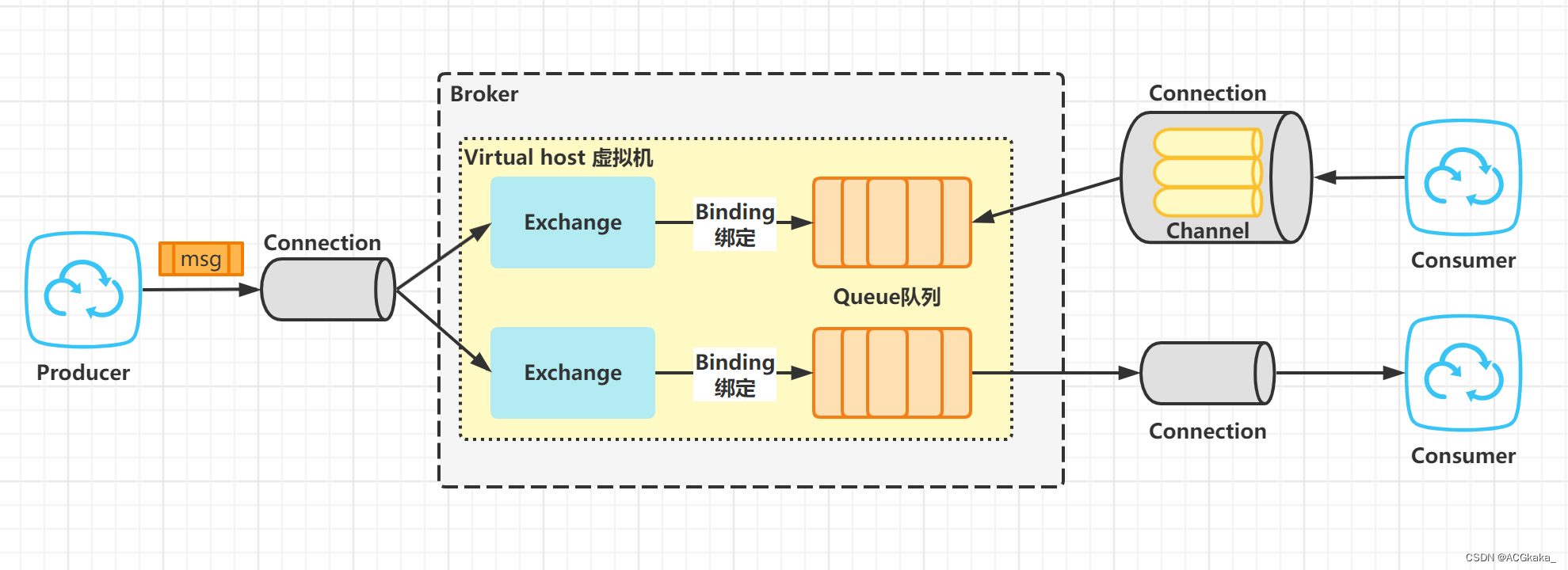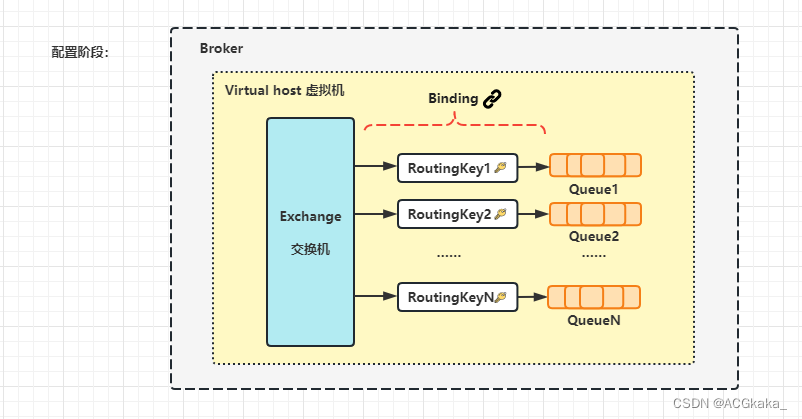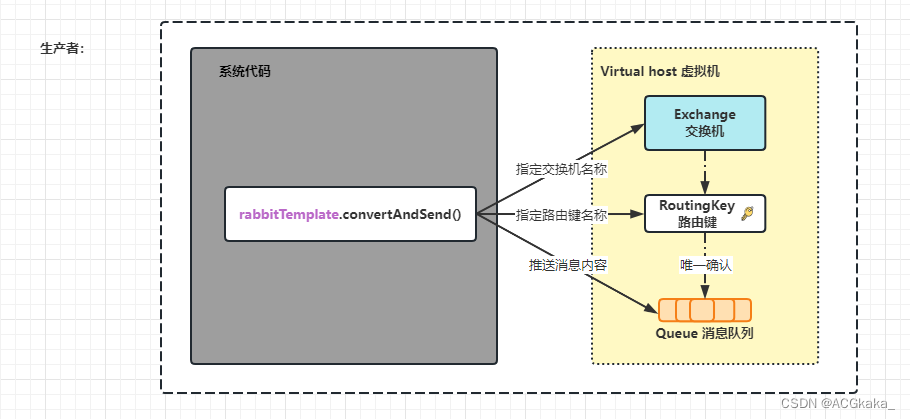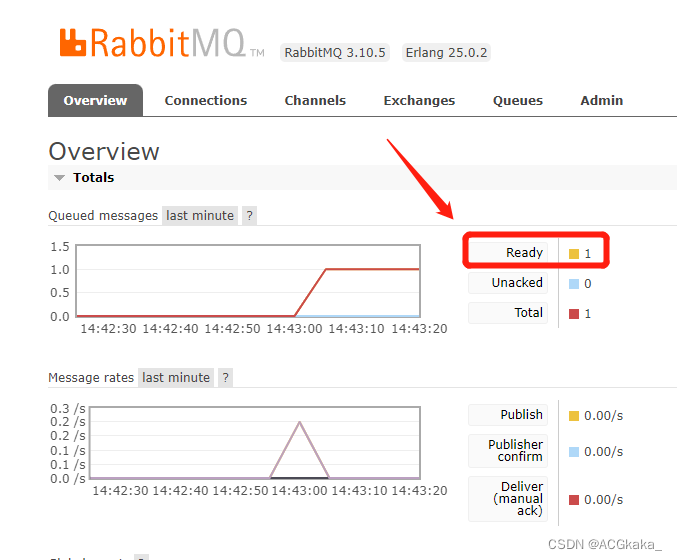SpringBoot实战(十一)集成RebbitMQ
目录
- 1.工作原理图
- 1.1 配置阶段
- 1.2 生产者
- 1.3 消费者
- 2.Maven依赖
- 3.常用交换机类型
- 3.1 direct 直连交换机
- 3.2 fanout 广播交换机
- 3.3 topic 主题交换机
- 4.Direct 直连交换机
- 4.1 yml配置
- 4.2 配置类
- 4.3 消息推送类
- 4.4 消息监听类
- 4.5 测试
- 5.Fanout 广播交换机
- 5.1 配置类
- 5.2 消息推送类
- 6.topic 主题交换机
- 6.1 配置类
- 6.2 消息推送类
- 7.源码地址
1.工作原理图

1.1 配置阶段
- 将
Queue(消息队列) 和Exchange(交换机)通过RoutingKey(路由键)进行绑定。

1.2 生产者
- 通过 Exchange(交换机)和 RoutingKey(路由键)唯一确认 Queue(消息队列),推送消息内容。

1.3 消费者
- 根据 Queue(消息队列)名称,接收新消息内容。

2.Maven依赖
<!-- RabbitMQ -->
<dependency>
<groupId>org.springframework.boot</groupId>
<artifactId>spring-boot-starter-amqp</artifactId>
<version>3.0.0</version>
</dependency>
3.常用交换机类型
3.1 direct 直连交换机
- 根据Exchange(交换机)和 RoutingKey(路由键)将消息推送给对应队列。
大致流程:
-
一个队列绑定到一个直连交换机上,同时赋予一个 RoutingKey(路由键)。
-
当消息通过生产者发送给 Exchange(交换机)时,Exchange(交换机)就会根据 RoutingKey(路由键)去找绑定的 Queue(消息队列)。
Exchange -> RoutingKey -> Queue
3.2 fanout 广播交换机
-
也叫扇形交换机,这种交换机没有 RoutingKey(路由键)概念,就算你绑定了路由键也是无视的。这个交换机在接收到消息后,会直接转发到绑定它上面的所有队列。
Exchange -> Queue
3.3 topic 主题交换机
- 这种交换机会根据通配符对 RoutingKey(路由键)进行匹配,只要 RoutingKey(路由键)满足匹配规则,就会被路由到对应的 Queue 上。
通配符的匹配规则:
- RoutingKey(路由键)必须是一串字符串,每个单词用”.“分隔;
- 符号 “#” 表示匹配一个或多个单词;
- 符号 “*” 表示匹配一个单词。
例如:
- “*.123” 能够匹配到 “abc.123”,但匹配不到 “abc.def.123”;
- “#.123” 能够匹配到 “abc.123”,也能匹配不到 “abc.def.123”。
4.Direct 直连交换机
4.1 yml配置
server:
port: 8081
spring:
application:
name: springboot-rabbitmq
rabbitmq:
host: 127.0.0.1
port: 5672
username: guest
password: guest
# 虚拟host 可以不设置,使用server默认host
virtual-host: /
# 是否开启发送端消息抵达队列的确认
publisher-returns: true
# 发送方确认机制,默认为NONE,即不进行确认;SIMPLE:同步等待消息确认;CORRELATED:异步确认
publisher-confirm-type: correlated
# 消费者监听相关配置
listener:
simple:
acknowledge-mode: auto # 确认模式,默认auto,自动确认;manual:手动确认
prefetch: 1 # 限制每次发送一条数据
concurrency: 3 # 同一个队列启动几个消费者
max-concurrency: 3 # 启动消费者最大数量
# 重试机制
retry:
# 开启消费者(程序出现异常)重试机制,默认开启并一直重试
enabled: true
# 最大重试次数
max-attempts: 3
# 重试间隔时间(毫秒)
initial-interval: 3000
4.2 配置类
RabbitDirectConfig.java
import org.springframework.amqp.core.Binding;
import org.springframework.amqp.core.BindingBuilder;
import org.springframework.amqp.core.DirectExchange;
import org.springframework.amqp.core.Queue;
import org.springframework.context.annotation.Bean;
import org.springframework.context.annotation.Configuration;
/**
* <p> @Title RabbitDirectConfig
* <p> @Description 直连交换机配置
* Direct Exchange是RabbitMQ默认的交换机模式,也是最简单的模式,根据key全文匹配去寻找队列。
*
* @author ACGkaka
* @date 2023/1/12 15:09
*/
@Configuration
public class RabbitDirectConfig {
/**
* 队列,命名:TestDirectQueue
*
* @return 队列
*/
@Bean
public Queue TestDirectQueue() {
// durable:是否持久化,默认是false,持久化队列:会被存储在磁盘上,当消息代理重启时仍然存在,暂存队列:当前连接有效
// exclusive:默认false,只能被当前创建的连接使用,而且当连接关闭后队列即被删除。此参考优先级高于durable。
// autoDelete:是否自动删除,当没有生产者或消费者使用此队列,该队列会自动删除。
// 一般设置一下队列的持久化就好,其余两个默认false
return new Queue("TestDirectQueue", true);
}
/**
* Direct交换机,命名:TestDirectExchange
* @return Direct交换机
*/
@Bean
DirectExchange TestDirectExchange() {
return new DirectExchange("TestDirectExchange", true, false);
}
/**
* 绑定 将队列和交换机绑定,并设置用于匹配键:TestDirectRouting
* @return 绑定
*/
@Bean
Binding bindingDirect() {
return BindingBuilder.bind(TestDirectQueue()).to(TestDirectExchange()).with("TestDirectRouting");
}
}
4.3 消息推送类
SendMessageController.java
import org.springframework.amqp.rabbit.core.RabbitTemplate;
import org.springframework.beans.factory.annotation.Autowired;
import org.springframework.web.bind.annotation.GetMapping;
import org.springframework.web.bind.annotation.RestController;
import java.time.LocalDateTime;
import java.time.format.DateTimeFormatter;
import java.util.HashMap;
import java.util.Map;
import java.util.UUID;
/**
* <p> @Title SendMessageController
* <p> @Description 推送消息接口
*
* @author ACGkaka
* @date 2023/1/12 15:23
*/
@RestController
public class SendMessageController {
/**
* 使用 RabbitTemplate,这提供了接收/发送等方法。
*/
@Autowired
private RabbitTemplate rabbitTemplate;
@GetMapping("/sendDirectMessage")
public String sendDirectMessage() {
String messageId = String.valueOf(UUID.randomUUID());
String messageData = "Hello world.";
String createTime = LocalDateTime.now().format(DateTimeFormatter.ofPattern("yyyy-MM-dd HH:mm:ss"));
Map<String, Object> map = new HashMap<>();
map.put("messageId", messageId);
map.put("messageData", messageData);
map.put("createTime", createTime);
// 将消息携带绑定键值:TestDirectRouting,发送到交换机:TestDirectExchange
rabbitTemplate.convertAndSend("TestDirectExchange", "TestDirectRouting", map);
return "OK";
}
}
4.4 消息监听类
DirectReceiver.java
import org.springframework.amqp.rabbit.annotation.RabbitHandler;
import org.springframework.amqp.rabbit.annotation.RabbitListener;
import org.springframework.stereotype.Component;
import java.util.Map;
/**
* <p> @Title DirectReceiver
* <p> @Description 直连型交换机监听类
*
* @author ACGkaka
* @date 2023/1/12 15:59
*/
@Component
@RabbitListener(queues = "TestDirectQueue")
public class DirectReceiver {
@RabbitHandler
public void process(Map testMessage) {
System.out.println("DirectReceiver消费者收到消息:" + testMessage.toString());
}
}
4.5 测试
1)先注释消息监听类,请求如下地址: http://localhost:8081/sendDirectMessage

2)打开RabbitMQ页面,可以看到有一条就绪待消费的消息。

3)打开消息监听类注释,重启项目,可以看到消息被消费了。


5.Fanout 广播交换机
5.1 配置类
import org.springframework.amqp.core.Binding;
import org.springframework.amqp.core.BindingBuilder;
import org.springframework.amqp.core.FanoutExchange;
import org.springframework.amqp.core.Queue;
import org.springframework.context.annotation.Bean;
import org.springframework.context.annotation.Configuration;
/**
* <p> @Title RabbitFanoutConfig
* <p> @Description 广播交换机配置
* Fanout 就是我们熟悉的广播模式或者订阅模式,给Fanout交换机发送消息,绑定了这个交换机的所有队列都收到这个消息。
*
* @author zhj
* @date 2023/1/16 5:42
*/
@Configuration
public class RabbitFanoutConfig {
public static final String FANOUT_QUEUE_NAME_1 = "testFanoutQueue1";
public static final String FANOUT_QUEUE_NAME_2 = "testFanoutQueue2";
@Bean
public Queue testFanoutQueue1() {
return new Queue(RabbitFanoutConfig.FANOUT_QUEUE_NAME_1);
}
@Bean
public Queue testFanoutQueue2() {
return new Queue(RabbitFanoutConfig.FANOUT_QUEUE_NAME_2);
}
/**
* 任何发送到Fanout Exchange的消息都会被转发到与该Exchange绑定(Binding)的所有队列上。
*/
@Bean
FanoutExchange testFanoutExchange() {
return new FanoutExchange("testFanoutExchange", true, false);
}
@Bean
Binding bindingFanout1(Queue testFanoutQueue1, FanoutExchange testFanoutExchange) {
return BindingBuilder.bind(testFanoutQueue1).to(testFanoutExchange);
}
@Bean
Binding bindingFanout2(Queue testFanoutQueue2, FanoutExchange testFanoutExchange) {
return BindingBuilder.bind(testFanoutQueue2).to(testFanoutExchange);
}
}
5.2 消息推送类
import org.springframework.amqp.rabbit.core.RabbitTemplate;
import org.springframework.beans.factory.annotation.Autowired;
import org.springframework.web.bind.annotation.GetMapping;
import org.springframework.web.bind.annotation.RestController;
import java.time.LocalDateTime;
import java.time.format.DateTimeFormatter;
import java.util.HashMap;
import java.util.Map;
import java.util.UUID;
/**
* <p> @Title SendMessageController
* <p> @Description 推送消息接口
*
* @author ACGkaka
* @date 2023/1/12 15:23
*/
@RestController
public class SendMessageController {
/**
* 使用 RabbitTemplate,这提供了接收/发送等方法。
*/
@Autowired
private RabbitTemplate rabbitTemplate;
@GetMapping("/sendFanoutMessage")
public String sendFanoutMessage() {
String messageId = String.valueOf(UUID.randomUUID());
String messageData = "Hello world.";
String createTime = LocalDateTime.now().format(DateTimeFormatter.ofPattern("yyyy-MM-dd HH:mm:ss"));
Map<String, Object> map = new HashMap<>();
map.put("messageId", messageId);
map.put("messageData", messageData);
map.put("createTime", createTime);
// 将消息携带绑定键值:testFanoutRouting,发送到交换机:testFanoutExchange
rabbitTemplate.convertAndSend("testFanoutExchange", "testFanoutRouting", map);
return "OK";
}
}
其余与 Direct 直连交换机基本相同,不再赘述。
6.topic 主题交换机
6.1 配置类
import org.springframework.amqp.core.Binding;
import org.springframework.amqp.core.BindingBuilder;
import org.springframework.amqp.core.Queue;
import org.springframework.amqp.core.TopicExchange;
import org.springframework.context.annotation.Bean;
import org.springframework.context.annotation.Configuration;
/**
* <p> @Title RabbitTopicConfig
* <p> @Description 主题交换机配置类
*
* @author zhj
* @date 2023/1/16 6:02
*/
@Configuration
public class RabbitTopicConfig {
public static final String TOPIC_QUEUE_NAME_1 = "testTopicQueue1";
public static final String TOPIC_QUEUE_NAME_2 = "testTopicQueue2";
public static final String TOPIC_QUEUE_NAME_3 = "testTopicQueue3";
public static final String TOPIC_EXCHANGE_NAME = "testTopicExchange";
public static final String TOPIC_ROUTING_NAME_1 = "test";
public static final String TOPIC_ROUTING_NAME_2 = "test.topic";
public static final String TOPIC_ROUTING_NAME_3 = "test.topic.message";
@Bean
public Queue testTopicQueue1() {
return new Queue(RabbitTopicConfig.TOPIC_QUEUE_NAME_1);
}
@Bean
public Queue testTopicQueue2() {
return new Queue(RabbitTopicConfig.TOPIC_QUEUE_NAME_2);
}
@Bean
public Queue testTopicQueue3() {
return new Queue(RabbitTopicConfig.TOPIC_QUEUE_NAME_3);
}
/**
* 交换机(Exchange) 描述:接收消息并且转发到绑定的队列,交换机不存储消息
*/
@Bean
TopicExchange testTopicExchange() {
return new TopicExchange(RabbitTopicConfig.TOPIC_EXCHANGE_NAME, true, false);
}
/**
* 綁定队列 testTopicQueue1() 到 testTopicExchange 交换机,路由键只接受完全匹配 test.topic1 的队列接受者可以收到消息
*/
@Bean
Binding bindingTestTopic1(Queue testTopicQueue1, TopicExchange testTopicExchange) {
return BindingBuilder.bind(testTopicQueue1).to(testTopicExchange).with(RabbitTopicConfig.TOPIC_ROUTING_NAME_1);
}
@Bean
Binding bindingTestTopic2(Queue testTopicQueue2, TopicExchange testTopicExchange) {
return BindingBuilder.bind(testTopicQueue2).to(testTopicExchange).with(RabbitTopicConfig.TOPIC_ROUTING_NAME_2);
}
@Bean
Binding bindingTestTopic3(Queue testTopicQueue3, TopicExchange testTopicExchange) {
return BindingBuilder.bind(testTopicQueue3).to(testTopicExchange).with(RabbitTopicConfig.TOPIC_ROUTING_NAME_3);
}
}
6.2 消息推送类
import com.demo.config.RabbitTopicConfig;
import org.springframework.amqp.rabbit.core.RabbitTemplate;
import org.springframework.beans.factory.annotation.Autowired;
import org.springframework.web.bind.annotation.GetMapping;
import org.springframework.web.bind.annotation.RestController;
import java.time.LocalDateTime;
import java.time.format.DateTimeFormatter;
import java.util.HashMap;
import java.util.Map;
import java.util.UUID;
/**
* <p> @Title SendMessageController
* <p> @Description 推送消息接口
*
* @author ACGkaka
* @date 2023/1/12 15:23
*/
@RestController
public class SendMessageController {
/**
* 使用 RabbitTemplate,这提供了接收/发送等方法。
*/
@Autowired
private RabbitTemplate rabbitTemplate;
@GetMapping("/sendTopicMessage")
public String sendTopicMessage() {
String messageId = String.valueOf(UUID.randomUUID());
String messageData = "Hello world.";
String createTime = LocalDateTime.now().format(DateTimeFormatter.ofPattern("yyyy-MM-dd HH:mm:ss"));
Map<String, Object> map = new HashMap<>();
map.put("messageId", messageId);
map.put("messageData", messageData);
map.put("createTime", createTime);
// 将消息携带绑定键值:testFanoutRouting,发送到交换机:testFanoutExchange
rabbitTemplate.convertAndSend(RabbitTopicConfig.TOPIC_EXCHANGE_NAME, "test.#", map);
return "OK";
}
}
其余与 Direct 直连交换机基本相同,不再赘述。
7.源码地址
参考地址:
1.Springboot 整合RabbitMq ,用心看完这一篇就够了,https://blog.csdn.net/qq_35387940/article/details/100514134
2.【RabbitMQ的那点事】如何保证消息的正确发送,https://www.jianshu.com/p/15f0c1a105fb
